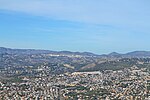Cap de la Nau
Geography of the Province of AlicanteHeadlands of SpainLandforms of the Valencian CommunityPages with Spanish IPAPages with Valencian IPA

The Cap de la Nau (Valencian: [ˈkab de la ˈnaw]) or Cabo de la Nao (Spanish: [ˈkaβo ðe la ˈnao]), literally Cape of the Ship, is a headland located central-eastern coastal Spain on the Gulf of Valencia, Mediterranean Sea. In English, it is also known as Cape Nao.
Excerpt from the Wikipedia article Cap de la Nau (License: CC BY-SA 3.0, Authors, Images).Cap de la Nau
Carretera Xàbia - Cap de la Nau,
Geographical coordinates (GPS) Address Nearby Places Show on map
Geographical coordinates (GPS)
| Latitude | Longitude |
|---|---|
| N 38.738611111111 ° | E 0.21666666666667 ° |
Address
Carretera Xàbia - Cap de la Nau
Carretera Xàbia - Cap de la Nau
03738 , Cap Martí
Valencian Community, Spain
Open on Google Maps









